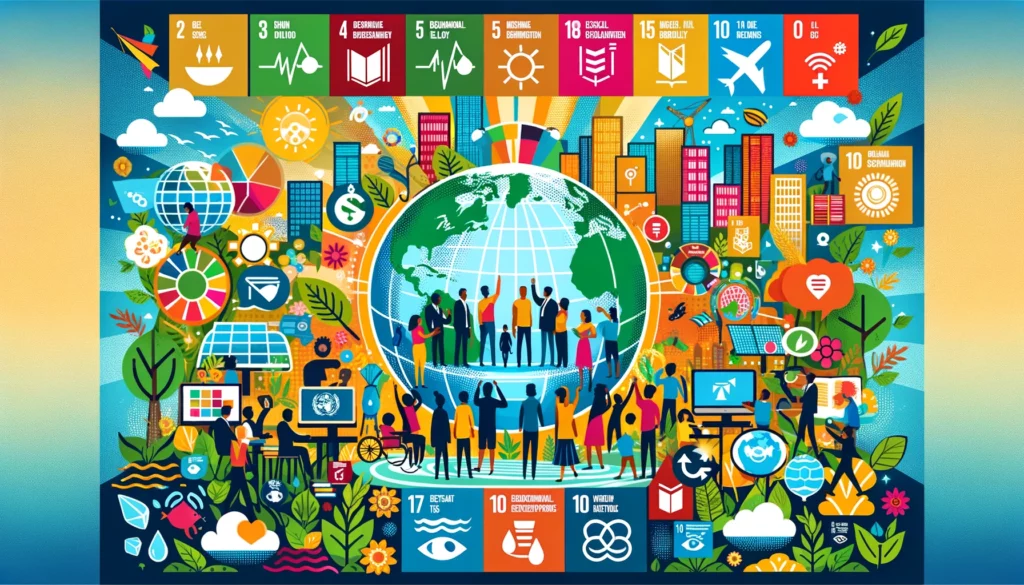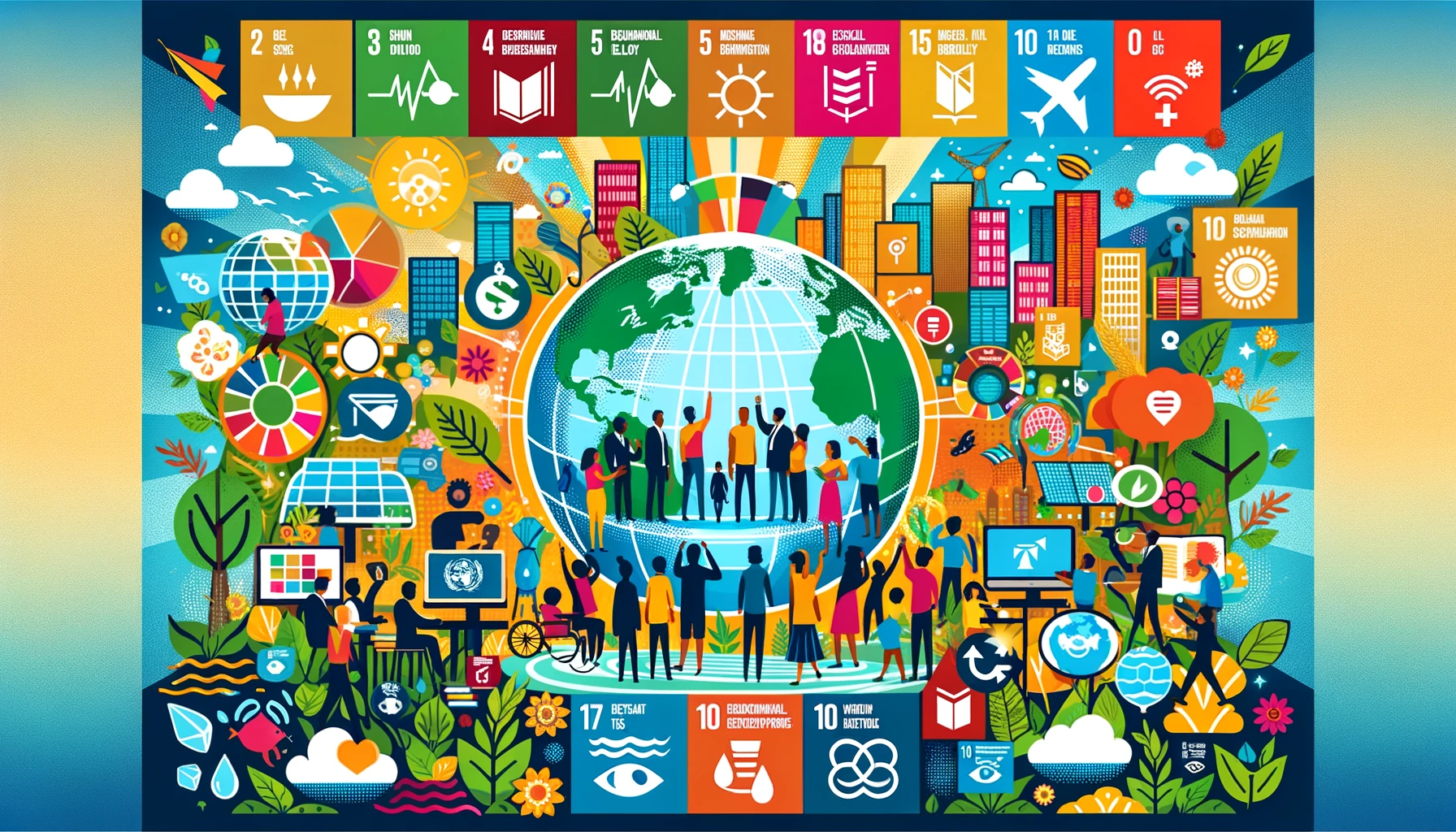Introduction
In 2015, the United Nations established the 2030 Agenda for Sustainable Development, a comprehensive framework aimed at addressing global challenges such as poverty, inequality, climate change, environmental degradation, and peace and justice. Central to this agenda is the 17 Sustainable Development Goals (SDGs), which provide a blueprint for achieving a better and more sustainable future for all. As we approach the halfway mark of 2030, it is crucial to assess our progress and identify strategies to accelerate our efforts towards these ambitious goals.
Understanding the Sustainable Development Goals (SDGs)
The SDGs are interconnected, recognizing that actions in one area will affect outcomes in others and that development must balance social, economic, and environmental sustainability. They include goals such as:
- No Poverty: End poverty in all its forms everywhere.
- Zero Hunger: End hunger, achieve food security and improved nutrition, and promote sustainable agriculture.
- Good Health and Well-being: Ensure healthy lives and promote well-being for all at all ages.
- Quality Education: Ensure inclusive and equitable quality education and promote lifelong learning opportunities for all.
- Gender Equality: Achieve gender equality and empower all women and girls.
- Clean Water and Sanitation: Ensure availability and sustainable management of water and sanitation for all.
- Affordable and Clean Energy: Ensure access to affordable, reliable, sustainable, and modern energy for all.
- Decent Work and Economic Growth: Promote sustained, inclusive, and sustainable economic growth, full and productive employment, and decent work for all.
- Industry, Innovation, and Infrastructure: Build resilient infrastructure, promote inclusive and sustainable industrialization, and foster innovation.
- Reduced Inequality: Reduce inequality within and among countries.
- Sustainable Cities and Communities: Make cities and human settlements inclusive, safe, resilient, and sustainable.
- Responsible Consumption and Production: Ensure sustainable consumption and production patterns.
- Climate Action: Take urgent action to combat climate change and its impacts.
- Life Below Water: Conserve and sustainably use the oceans, seas, and marine resources for sustainable development.
- Life on Land: Protect, restore, and promote sustainable use of terrestrial ecosystems, sustainably manage forests, combat desertification, and halt and reverse land degradation and biodiversity loss.
- Peace, Justice, and Strong Institutions: Promote peaceful and inclusive societies for sustainable development, provide access to justice for all, and build effective, accountable, and inclusive institutions at all levels.
- Partnerships for the Goals: Strengthen the means of implementation and revitalize the Global Partnership for Sustainable Development.
Current Progress and Challenges
Significant progress has been made towards achieving many of the SDGs. For instance, extreme poverty rates have declined, more people have access to clean water and sanitation, and advancements in renewable energy are transforming the global energy landscape. However, challenges remain, and in some areas, progress has been slow or even reversed, mainly due to the COVID-19 pandemic, which has exacerbated inequalities and stalled development efforts.
Strategies for Achieving the SDGs
- Integrated Approach: Addressing the SDGs requires an integrated approach that considers the interconnectedness of goals. Policies and initiatives must be designed to maximize synergies and minimize trade-offs. For example, sustainable agricultural practices can improve food security (Goal 2), reduce poverty (Goal 1), and combat climate change (Goal 13).
- Multi-stakeholder Partnerships: Achieving the SDGs necessitates collaboration across sectors and stakeholders, including governments, businesses, civil society, and academia. Partnerships can leverage diverse expertise, resources, and networks to drive sustainable development.
- Innovative Financing: Financing the SDGs remains a significant challenge. Innovative financing mechanisms, such as green bonds, social impact bonds, and blended finance, can mobilize additional resources and investment for sustainable development projects.
- Data and Monitoring: Accurate data and effective monitoring are crucial for tracking progress towards the SDGs. Data-driven decision-making can identify gaps, inform policy, and ensure accountability.
- Education and Awareness: Raising awareness and educating the public about the SDGs is essential for building support and driving action. Educational institutions, media, and community organizations play a vital role in disseminating knowledge and fostering a culture of sustainability.

Examples of Success
Several countries and organizations have made notable strides in advancing the SDGs. For instance, Denmark has integrated the SDGs into its national policies and has established a national action plan to achieve them. Costa Rica has made significant progress in environmental sustainability, with ambitious goals for renewable energy and biodiversity conservation. Additionally, many businesses are aligning their strategies with the SDGs, recognizing that sustainable practices can drive innovation and long-term success.
The Role of Technology
Technology plays a critical role in achieving the SDGs. Innovations in clean energy, digitalization, and biotechnology offer new solutions to longstanding challenges. For example, precision agriculture technologies can enhance food security by optimizing resource use and increasing crop yields. Similarly, advancements in renewable energy technologies are making clean energy more accessible and affordable.
Engaging Communities
Community engagement is fundamental to achieving the SDGs. Local communities are often the most affected by development challenges and are best positioned to identify and implement effective solutions. Empowering communities through participatory approaches ensures that development initiatives are inclusive and responsive to local needs.
Conclusion
Achieving the Sustainable Development Goals is a formidable challenge, but it is also an unprecedented opportunity to transform our world for the better. By adopting integrated approaches, fostering multi-stakeholder partnerships, leveraging innovative financing, utilizing technology, and engaging communities, we can accelerate progress toward a sustainable and equitable future for all. As we move forward, it is crucial to remain committed to the principles of sustainability and to work collaboratively across sectors and borders to realize the vision of the 2030 Agenda.
What are the Sustainable Development Goals (SDGs)?
The Sustainable Development Goals (SDGs) are a set of 17 global goals established by the United Nations in 2015 to address a wide range of social, economic, and environmental challenges. These goals aim to end poverty, protect the planet, and ensure prosperity for all by 2030. The SDGs are interconnected, recognizing that progress in one area can influence outcomes in others and that sustainable development must balance social, economic, and environmental sustainability.
Why are the SDGs Important?
The SDGs are crucial because they provide a comprehensive framework for addressing the most pressing global challenges. By focusing on areas such as poverty eradication, health, education, gender equality, clean water and sanitation, and climate action, the SDGs aim to create a more equitable and sustainable world. Achieving these goals requires coordinated efforts from governments, businesses, civil society, and individuals.
How Can We Achieve the Sustainable Development Goals?
Achieving the SDGs involves several vital strategies:
- Integrated Approaches: Policies and initiatives should consider the interconnected nature of the SDGs, maximizing synergies and minimizing trade-offs.
- Multi-stakeholder Partnerships: Collaboration across sectors and stakeholders is essential for leveraging diverse expertise and resources.
- Innovative Financing: Mobilizing additional resources through innovative financing mechanisms can support sustainable development projects.
- Data and Monitoring: Accurate data and effective monitoring are crucial for tracking progress and ensuring accountability.
- Education and Awareness: Raising awareness and educating the public about the SDGs is essential for building support and driving action.
The Sustainable Development Goals represent a bold vision for a better future. By working together and implementing effective strategies, we can achieve these goals and create a sustainable and equitable world for all.

